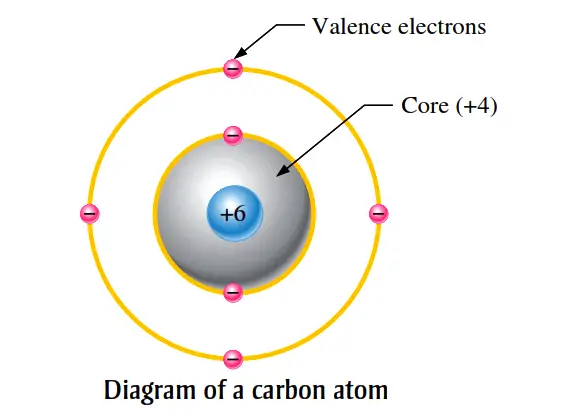All materials are made up of atoms. These atoms contribute to the electrical properties of a material, including its ability to conduct electrical current.

For purposes of discussing electrical properties, an atom can be represented by the valence shell and a core that consists of all the inner shells and the nucleus. This concept is illustrated in above Figure for a carbon atom. Carbon is used in some types of electrical resistors. Notice that the carbon atom has four electrons in the valence shell and two electrons in the inner shell. The nucleus consists of six protons and six neutrons so the six indicates the positive charge of the six protons. The core has a net charge of 4.
Insulators
An insulator is a material that does not conduct electrical current under normal conditions. Most good insulators are compounds rather than single-element materials and have very high resistivities. Valence electrons are tightly bound to the atoms; therefore, there are very few free electrons in an insulator. Examples of insulators are rubber plastics, glass, mica, and quartz.
Conductors
A conductor is a material that easily conducts electrical current. Most metals are good conductors. The best conductors are single-element materials, such as copper (Cu), silver (Ag), gold (Au), and aluminum (Al), which are characterized by atoms with only one valence electron very loosely bound to the atom. These loosely bound valence electrons become free electrons. Therefore, in a conductive material the free electrons are valence electrons.
Semiconductors
A semiconductor is a material that is between conductors and insulators in its ability to conduct electrical current. A semiconductor in its pure (intrinsic) state is neither a good conductor nor a good insulator. Single-element semiconductors are antimony (Sb), arsenic (As), astatine (At), boron (B), polonium (Po), tellurium (Te), silicon (Si), and germanium (Ge). Compound semiconductors such as gallium arsenide, indium phosphide, gallium nitride, silicon carbide, and silicon germanium are also commonly used. The single-element semiconductors are characterized by atoms with four valence electrons. Silicon is the most commonly used semiconductor.
The conveyor sorting machine is widely used in the packing industries using the PLC program…
Learn the example of flip-flop PLC program for lamps application using the ladder logic to…
In this article, you will learn the STAR DELTA programming using PLC controller to start…
Lube oil consoles of rotary equipment packages in industrial process plants are usually equipped with…
Rotating equipment packages such as pumps, compressors, turbines need the lube oil consoles for their…
This article explains how to blink lights in ladder logic with a detailed explanation video…
View Comments
Your explanation are of good, such that I have learned and understand what insulators and conductors are.